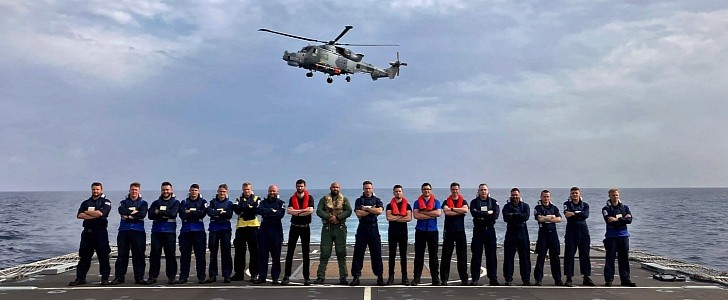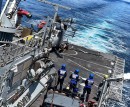If you ever thought that the joint operations of military vessels and helicopters are easy, you’d be surprised to know that it’s a complex process, requiring a very delicate balance between the helicopter’s weight, the movement of the ship, and the wind. The Royal Navy carried out challenging demonstrations to test this balance and determine the best parameters for safe operation.
HMS Trent, a second-generation River-class patrol vessel, and a specially-modified Navy Wildcat helicopter were the stars of the show during the Royal Navy’s recent trials. Instead of the typical crew, the Wildcat carried four test pilots from the Rotary Wing Test and Evaluation Squadron and two QinetiQ flight test engineers. In addition, more than 20 engineers and technicians made sure that the aircraft was in top shape at all times.
Several sensors fitted on both the helicopter and the patrol ship, some of which are not normally available to them, were used to record huge amounts of data. The Wildcat crew showed what it can do both in the daytime and at night. When it got dark, the pilots practiced operating with or without night vision goggles.
In total, the helicopter landed and took off more than 200 times from the flight deck of HMS Trent. And these operations were performed in as many conditions as possible. To take advantage of various wind and sea conditions, the HMS Trent vessel traveled to both the Mediterranean and the Atlantic.
The goal of all this was to accurately determine the limits of the helicopter’s operations in conjunction with a warship. The official term for that is “Ship Helicopter Operating Limits,” and it basically defines safe flying.
This was the Royal Navy’s most extensive test using the Wildcat and a River-class patrol vessel. The feedback will also be used for larger helicopters such as Merlin, as well as other NATO aircraft. The Wildcat got to show what it can do, even in challenging conditions, while HMS Trent will use this data to take its maritime security tasks to the next level.
Several sensors fitted on both the helicopter and the patrol ship, some of which are not normally available to them, were used to record huge amounts of data. The Wildcat crew showed what it can do both in the daytime and at night. When it got dark, the pilots practiced operating with or without night vision goggles.
In total, the helicopter landed and took off more than 200 times from the flight deck of HMS Trent. And these operations were performed in as many conditions as possible. To take advantage of various wind and sea conditions, the HMS Trent vessel traveled to both the Mediterranean and the Atlantic.
The goal of all this was to accurately determine the limits of the helicopter’s operations in conjunction with a warship. The official term for that is “Ship Helicopter Operating Limits,” and it basically defines safe flying.
This was the Royal Navy’s most extensive test using the Wildcat and a River-class patrol vessel. The feedback will also be used for larger helicopters such as Merlin, as well as other NATO aircraft. The Wildcat got to show what it can do, even in challenging conditions, while HMS Trent will use this data to take its maritime security tasks to the next level.






